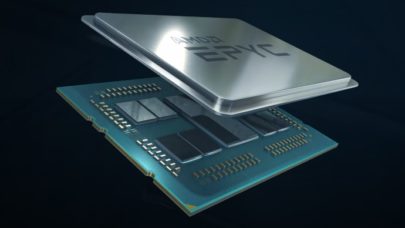
AMD Launches Epyc ‘Milan’ with 19 SKUs for HPC, Enterprise and Hyperscale
March 15, 2021
At a virtual launch event held today (Monday), AMD revealed its third-generation Epyc “Milan” CPU lineup: a set of 19 SKUs -- including the flagship 64-core, 280-watt 7763 part -- aimed at HPC, enterprise and cloud workloads. Notably, the third-gen Epyc Milan chips achieve 19 percent... Read more…

AMD’s Q1 Sets Records and Meets Expectations, but COVID-19 Looms
April 29, 2020
AMD has reported its Q1 2020 revenue, slightly outperforming analyst expectations and dodging the first financial blows of COVID-19 to deliver $1.79 billion – a whopping 40 percent year-over-year growth in revenue, and a record for first-quarter earnings. The year-over-year growth was primarily driven by the computing and graphics segment... Read more…

AMD Launches Three New High-Frequency Epyc SKUs Aimed at Commercial HPC
April 14, 2020
AMD is launching three new SKUs today based on the 7nm second-generation Epyc "Rome" platform, targeting commercial HPC workloads as well as hyperconverged infr Read more…

AMD Epyc CPUs Now on Bare Metal IBM Cloud Servers
April 1, 2020
AMD’s expanding presence in the datacenter and cloud computing markets took a step forward with today’s announcement that its 7nm 2nd Gen Epyc 7642 CPUs are Read more…

Cray to Provide NOAA with Two AMD-Powered Supercomputers
February 24, 2020
The United States’ National Oceanic and Atmospheric Administration (NOAA) last week announced plans for a major refresh of its operational weather forecasting supercomputers, part of a 10-year, $505.2 million program, which will secure two HPE-Cray systems for NOAA’s National Weather Service to be fielded later this year and put into production in early 2022. Read more…

China’s Tencent Server Design Will Use AMD Rome
November 13, 2019
Tencent, the Chinese cloud giant, said it would use AMD’s newest Epyc processor in its internally-designed server. The design win adds further momentum to AMD Read more…

Azure Cloud First with AMD Epyc Rome Processors
November 6, 2019
At Ignite 2019 this week, Microsoft's Azure cloud team and AMD announced an expansion of their partnership that began in 2017 when Azure debuted Epyc-backed instances for storage workloads. The fourth-generation Azure D-series and E-series virtual machines previewed at the Rome launch in August are now generally available. Read more…

Dell Ramps Up HPC Testing of AMD Rome Processors
October 21, 2019
Dell Technologies is wading deeper into the AMD-based systems market with a growing evaluation program for the latest Epyc (Rome) microprocessors from AMD. In a Read more…

- Click Here for More Headlines

Whitepaper
From Hallucination to Reality
As Federal agencies navigate an increasingly complex and data-driven world, learning how to get the most out of high-performance computing (HPC), artificial intelligence (AI), and machine learning (ML) technologies is imperative to their mission. These technologies can significantly improve efficiency and effectiveness and drive innovation to serve citizens' needs better. Implementing HPC and AI solutions in government can bring challenges and pain points like fragmented datasets, computational hurdles when training ML models, and ethical implications of AI-driven decision-making. Still, CTG Federal, Dell Technologies, and NVIDIA unite to unlock new possibilities and seamlessly integrate HPC capabilities into existing enterprise architectures. This integration empowers organizations to glean actionable insights, improve decision-making, and gain a competitive edge across various domains, from supply chain optimization to financial modeling and beyond.
Download Now
Sponsored by CGT Federal
Whitepaper
Why IT Must Have an Influential Role in Strategic Decisions About Sustainability
Data centers are experiencing increasing power consumption, space constraints and cooling demands due to the unprecedented computing power required by today’s chips and servers. HVAC cooling systems consume approximately 40% of a data center’s electricity. These systems traditionally use air conditioning, air handling and fans to cool the data center facility and IT equipment, ultimately resulting in high energy consumption and high carbon emissions. Data centers are moving to direct liquid cooled (DLC) systems to improve cooling efficiency thus lowering their PUE, operating expenses (OPEX) and carbon footprint.
This paper describes how CoolIT Systems (CoolIT) meets the need for improved energy efficiency in data centers and includes case studies that show how CoolIT’s DLC solutions improve energy efficiency, increase rack density, lower OPEX, and enable sustainability programs. CoolIT is the global market and innovation leader in scalable DLC solutions for the world’s most demanding computing environments. CoolIT’s end-to-end solutions meet the rising demand in cooling and the rising demand for energy efficiency.
Download Now
Sponsored by Lenovo
Advanced Scale Career Development & Workforce Enhancement Center
Featured Advanced Scale Jobs:
SUBSCRIBE for monthly job listings and articles on HPC careers.
HPCwire Resource Library
HPCwire Product Showcase
© 2024 HPCwire. All Rights Reserved. A Tabor Communications Publication
HPCwire is a registered trademark of Tabor Communications, Inc. Use of this site is governed by our Terms of Use and Privacy Policy.
Reproduction in whole or in part in any form or medium without express written permission of Tabor Communications, Inc. is prohibited.




























